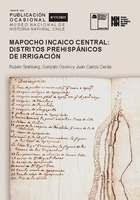2021, 60 páginas.
Publicación Ocasional 71
Mapocho incaico central: distritos prehispánicos de irrigación
Resumen
Este artículo explora la forma en que el Estado Inca reorganizó administrativamente el valle del Mapocho y sectores colindantes del valle del Maipo tras, necesariamente, llegar a acuerdo con las autoridades locales. Se postula que el territorio fue dividido en varios distritos de irrigación para lo cual se trajeron mitimaes (colonos) con conocimientos técnicos de hidroagricultura, mientras que los caciques locales aliados proporcionaron la fuerza de trabajo necesaria para la apertura de grandes canales. De esta manera, se incorporaron al riego miles de nuevas hectáreas anteriormente poco explotadas agrícolamente. Muchos habitantes locales y gente venida de otras partes se fueron a residir en las chacras distribuidas a lo largo de estos sistemas de riego.
Tras la fundación de la ciudad de Santiago, en febrero de 1541, los españoles se repartieron estas chacras con su respectivo sistema de canales y acequias con lo cual pudieron sostener La Conquista y el naciente Reino de Chile. A partir de documentación jurídica europea, principalmente títulos de merced de chacras, se reconstruye cada uno de estos canales proporcionando su correspondiente referencia y mapa.
Palabras claves: Incas, Tawantinsuyu, valle Mapocho, valle Maipo, canales, irrigación
Abstract
This article explores the way in which the Inca State reorganized the Mapocho valley and neighboring sectors of the Maipo valley, after reaching an agreement with the local authorities. It is postulated that the territory was divided into several irrigation districts for which mitimaes (settlers) with technical knowledge of hydroagriculture were brought, while the local allied caciques provided the necessary workforce for the opening of large channels. In this way, thousands of new hectares, minimally exploited for agriculture previously, were incorporated into the irrigation network. Many local inhabitants and people from other parts of the country resettled into the farms distributed along these irrigation systems.
After the founding of the city of Santiago, in February 1541, the Spaniards divided up these farms amongst them, with their respective systems of channels and ditches, which enabled them to sustain the Conquest and the nascent Kingdom of Chile. Based on European legal documents, mainly from land titles (títulos de "Merced de Chacras"), each of these channels is reconstructed, providing its corresponding reference and map.
Keywords: Incas, Tawantinsuyu, Mapocho valley, Maipo valley, channels, irrigation


